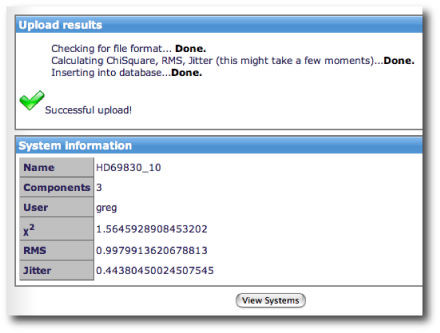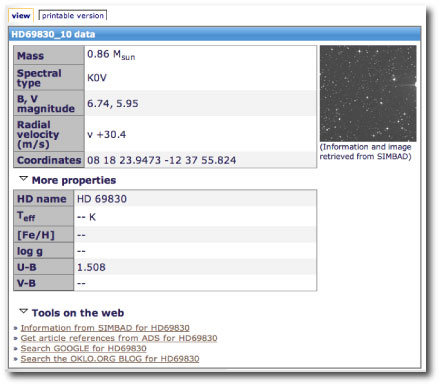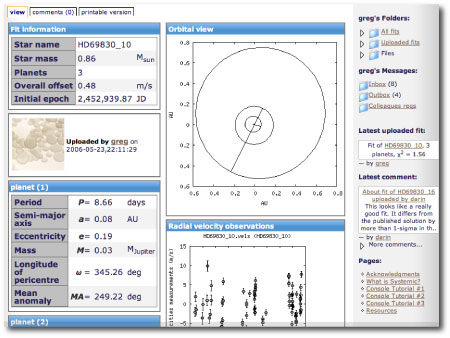
Hats off to everyone who’s downloaded the console, logged into the backend, and submitted fits for the HD 69830 data sets. The process now seems to be working smoothly, but we need more users. Don’t be shy! We won’t make fun of you if you turn in high-chi-square fits.
First, a follow-up note to yesterday’s post: Some of our original HD 69830-based data files did not have all their radial velocities listed in time-ascending order. This caused the periodogram generator to fail when asked to analyze these data sets. If you downloaded the console yesterday, please download a fresh copy. The version on the site now has the correctly bundled data files.
The published radial velocity data sets consist of lists of times (in Julian Days), radial velocities (relative to an average baseline velocity), and uncertainty estimates for each velocity. These uncertainty estimates give an indication of how much imprecision is introduced at the telescope and by the measurement process itself. An additional source of velocity error, generally referred to as stellar jitter, is not contained in the published uncertainty estimates. Stellar jitter is produced by various processes that are occurring on the star itself. For example, at any given moment in time, there may be a larger portion of the stellar surface upwelling than downwelling, leading to a slight, temporary, net negative radial velocity. It has generally been assumed that for a Solar-type star, stellar jitter contributes roughly 3-5 meters per second of radial velocity error, and it is certainly true that stars somewhat more massive than the Sun (Upsilon Andromedae, for example) display close to 10 meters per second of intrinsic jitter.
Recently, however, as the radial velocity observational techniques have improved, it has become clear that some stars — low mass stars in particular — can have very small intrinsic jitter. Eugenio’s analysis of the GJ 876 radial velocities indicate that the jitter in that case is almost certainly less than 2-3 meters per second. HD 69830, however, seems to be in another category altogether. The published three-planet fit suggests that the star has considerably less than 1 meter per second intrinsic jitter. If this is indeed the case, and if there are a sizeable number of stars that are as quiet as HD 69830 seems to be, then it’s clear that high-cadence observations using the RV method are destined to eventually uncover potentially habitable planets, and likely sooner, rather than later. That’s a big deal.
The twenty alternate data sets for HD 69830 have been constructed to help us test whether the stellar jitter is really as small as the fit to the actual data suggests. Some of the synthetic data sets have been produced by adopting a model in which the stellar jitter is higher than 1 m/s. It should not be possible to find fully correct chi-square ~ 1 fits to these jittery data sets. In other words if we do find chi-square ~ 1 fits to these sets, then we’ve got a strong suggestion that overfitting might be occuring in the chi-square ~ 1 fits to the real data.
I’ll wrap up today with a set of screenshots showing how the backend environment operates. The best way to learn how it works, however, is to login and start using it. It’s quite self-explanatory.
After you’ve uploaded a fit from your own computer, you’ll get a response page that looks like this if the upload was successful:

Make sure that your fit file is appended with the suffix “.fit” before you upload it.
If you click on “view systems”, you’ll see a list of all the systems that have been added to the console thus far. All of the fits that have been uploaded by the systemic collaboration can be accessed from this catalog page. As of tonight, most of the systems have not yet been fitted…

Clicking on a system name brings up the corresponding system data page. There’s quite a bit of information available:

If you click on the icon next to a particular fit:

Then information about the planetary system corresponding to that fit is displayed:

Let’s see some activity! These planets won’t fit themselves…

After downloading the updated Systemic console, I was unable to run it, either by double-clicking the .jar file or from the command line. It turns out that it was operator error. When I unzipped the file, I didn’t check the option to “use folder names.” When unzipped correctly, the files are put into three sub-directories under the Systemic root directory – datafiles, fits and soundClips. Once the unzip waa done correctly, everything worked.
Kent – good to hear that it’s working for you! Glad to have you on board the collaboration side of systemic as well as the photometric observational side of transitsearch.org.